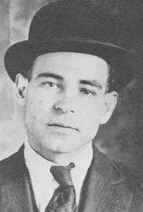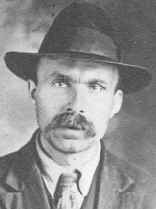Deaths which
occurred on an August 23: ^top^
2002 Two of three Palestinians dressed in Israeli army uniforms
and armed with assault rifles and grenades whose attempt to infiltrate,
just before daybreak, the Jewish enclave settlement of Kfar Darom, in
central Gaza, is foiled by the Israeli soldiers who shoot them.
2001 Mahmoud Zourab, 11, Palestinian shot through the heart by
Israeli troops in the Gaza Strip in a clash following the funeral of
a Palestinian killed a day earlier. Palestinian youths were throwing
stones at an Israeli enclave settlement.
2001 Francisco de Assis Santana “Chico Quele”, 56,
a Xukuru Amerindian, is hit in the morning by two blasts from a 12-gauge
shotgun near the village of Pe de Serra, Pernambuco state. The Catholic
Church-linked Indigenous Missionary Council says that Santana was on
a list of Amerindian leaders targeted by some militant settlers resisting
their removal from the Xukuru Indian reservation about 2000 km northeast
of Rio de Janeiro. Santana was instrumental in the Xukurus' long-running
battle to have their ancestral lands set aside an Indian reservation.
For many years he worked closely with chief Xicao Xukuru, whao was fatally
shot in 1998. Tensions between Amerindians and non-Amerindians who settled
on the ancestral Xukuru lands have often led to violence. Brazil's government
recognized the 275-square-kilometer Xukuru reservation earlier in 2001,
but nearly 300 settlers remain on the land, saying that they want compensation
from the federal government before they leave. The gunmen ran in the
direction of a ranch whose owner, Jose Cordeiro de Santana, is said to
have planned Xicao Xukuru's killing.
2000 John Anthony Kaiser,
67, murdered by a shotgun blast to the head, presumably on orders
from government officials of Kenya, where he was a US Catholic
missionary priest vocal in defense of human rights.
Father Kaiser came into the limelight
in 1998 when he gave information to the Akiwumi Commission on
tribal clashes concerning the origin of the violence, naming
some powerful Cabinet Ministers and provincial administration
figures as the main perpetrators. As late as 1999, he accused
two Cabinet Ministers of sending youths to Israel for commando
training to come back and initiate the clashes. It so happens
that the two ministers were also on his list of those who financed
the 1992 carnage. The priest has tangled with other senior Kenyan
government officials accused of crime.
23 Aug 2001 update.
On this first anniversary day,
human rights groups demand a Kenyan public inquest into the
mysterious death of Father Kaiser, claiming that an FBI investigation
was flawed.
The Rev. John Kaiser, 67, of
Perham, Minn., was found dead last on 24 Aug 2000 along a highway
with a gunshot wound to the back of his head. A shotgun was
discovered nearby and his truck was located in a ditch. Police
at the scene initially said they believed he was slain and that
it was made to look like a suicide. But an FBI report in April
2001 claimed that Kaiser was depressed and put a shotgun to
the back of his head and pulled the trigger.
At a symposium on the anniversary
of his death, the Kenyan Human Rights Network joins the Catholic
Church in rejecting the FBI's finding of a self-inflicted wound.
The network of human rights organizations said a public inquest
was needed to determine the exact circumstances behind the death.
Kaiser was known in Kenya as
the "the rhino for the poor" because of his work to expose human
rights violations committed by government officials and powerful
politicians. He had worked in Kenya for 35 years. He publicly
accused Cabinet ministers of engineering ethnic fighting and
helped bring a private prosecution for rape against one of them.
The FBI entered the case after
President Daniel arap Moi agreed to allow a team of agents to
join the Kenyan police investigation. The US Congress later
demanded an FBI report on the death. The FBI report released
in April 2001 concluded that Kaiser's death was "most consistent
with death resulting from a self-inflicted gunshot wound to
the head." The 81-page document was not a formal crime report
and the FBI acknowledged that "this analysis is not a substitute
for a thorough well-planned investigation and should not be
considered all inclusive."
The report was immediately condemned
by Kenya's Catholic bishops and Sen. Paul Wellstone of Minnesota,
who called for further investigation. Dr. Ling Kitui, a physician
who works with torture victims and attended the autopsy, said
she felt the FBI report emphasized evidence that suggested suicide
while ignoring evidence that suggested otherwise. She also questioned
the FBI decision to rely heavily on circumstantial evidence
that Kaiser had a history of depression and was behaving strangely
in the days before his death.
Kaiser's close friend, Sister
Brangan Nurula, said the FBI misrepresented her discussions
with them as well as what others had said about Kaiser. "They
selected items from the interviews, from which they built up
the theory of suicide," Nurula said. "But they didn't use other
information that suggested otherwise."
FBI officials have rejected Wellstone's
call for further investigation, and Kenyan Attorney General
Amos Wako has dodged requests for an inquest. An inquest would
allow Kaiser's family and the church to call witnesses and review
the evidence. Kenya's Catholic bishops plan to launch a letter-writing
campaign on Sunday 26 August 2001. Catholic churches in the
United States also plan memorial masses over the weekend. |
2000 Pilot Ihsan Shakeeb and all the other 142 persons aboard
a Gulf Air Airbus which crashes into the Persian Gulf near Bahrain, dued
to pilot error: he aborted his landing and nosed the plane down instead
of up. (The final
investigation report would be released on 15 July 2002).
1989 Yusef Hawkins, 16, shot by 30 Whites in the Bensonhurst section
of Brooklyn. because he's Black 1989, in a case that inflamed racial
tensions in New York City.
1986 Más de 2000 personas en Camerún por las emanaciones tóxicas
del Lago Nios, situado sobre un volcán.
1973 Hellmuth
Kneser, mathematician.
1960 Oscar Hammerstein II, 65, Broadway librettist, in Doylestown,
Pa.
1952 Frederick George Kenyon, 89, British archaeologist and language
scholar. Kenyon devoted his life to discovering biblical parallels in
ancient Greek papyri, convincing critics that science does not disprove
the Bible.
1949 Domingo Díaz Arosemena, presidente de Panamá.
1942: 40'000 Stalingrad civilians,
by Nazi bombing ^top^
During World War II, the German
Sixth Army sights the Russian city of Stalingrad on the banks
of the Volga River, the pre-designated boundary of the Third
Reich. As the Sixth Army approaches Stalingrad, the German Fourth
Air Fleet under General Wolfram von Richthofen reduces the city
to a burning rubble, killing over forty thousand civilians.
As part of the summer campaign
by German forces in Russia, the Sixth Army under Field Marshall
Friedrich von Paulus was to take Stalingrad, an industrial center
and obstacle to Nazi control of the precious Caucasian oil wells.
At the beginning of September, General Paulus ordered the first
offensives into the suburbs of Stalingrad, estimating that it
would take his army about ten days to capture the city. Thus
began the most horrific battle of World War II, and arguably
the most important because it marked the turning point in the
war between Nazi Germany and the USSR.
In Stalingrad, the German Sixth
Army faced a bitter Red Army employing the ruined city to their
advantage, transforming destroyed buildings and rubble into
natural fortifications. In a method of fighting the Germans
began to call the Rattenkrieg, or "Rat's War," the opposing
forces broke into squads eight or ten strong, and fought each
other for every house and yard of territory. The battle saw
rapid advances in the technology of street fighting, such as
a German machine gun that shot around corners and a light Russian
plane that glided silently over German positions at night, dropping
lethal bombs without warning.
However, both sides lacked the
necessary food, water, or medical supplies, and tens of thousands
perished. Soviet leader Joseph Stalin was determined to liberate
the city named after him, and in November, he ordered massive
reinforcements to the area. On November 19, the Red Army under
General Georgi Zhukov launched Operation Uranus, the great Soviet
counter-offensive, out of the rubble of Stalingrad.
German command underestimated
the scale of the counterattack, and the Sixth Army was quickly
overwhelmed by the offensive, which involved eleven Soviet armies,
900 tanks, and 1400 aircraft. Within three days, the entire
German force of over 200'000 men was encircled. For the next
two months, the Germans desperately hung on, waiting for reinforcements
that never came. Starvation and the bitter Russian winter took
as many lives as the merciless Soviet troops, and when Field
Marshal Friedrich Von Paulus finally surrendered on 2 February
1943, only 90'000 German soldiers were still alive. |
  1927
Nicola Sacco [<<<],
36, and Bartolomeo Vanzetti [>>>],
39, on the electric chair, in Massachusetts
^top^ 1927
Nicola Sacco [<<<],
36, and Bartolomeo Vanzetti [>>>],
39, on the electric chair, in Massachusetts
^top^
after a controversial murder trial extending over seven years,
1920-27
The trial resulted from the murders
in South Braintree, Massachusetts, on 15 April 1920, of F.A.
Parmenter, paymaster of a shoe factory, and Alessandro Berardelli,
the guard accompanying him, in order to secure the payroll of
over $15'000 that they were carrying. On 05 May 1920, after
going to a garage to claim a car that police said was connected
with the crime, Nicola
Sacco [born 22 April 1891] and Bartolomeo
Vanzetti [born 11 June 1888], two Italian anarchists who
had immigrated to the United States in 1908, Sacco a shoe-factory
worker and Vanzetti a fish peddler, were arrested for the crime.
Both men carried guns and made false statements upon their arrest,
but neither had a previous criminal record. On 31 May 1921,
they were brought to trial before Judge Webster Thayer of the
Massachusetts Superior Court, and on 14 July 1921 both were
found guilty by verdict of the jury and sentenced to die.
Socialists and radicals protested
the men's innocence. Many people felt that there had been less
than a fair trial and that the defendants had been convicted
for their radical, anarchist beliefs rather than for the crime
for which they had been tried. All attempts for retrial on the
ground of false identification failed. On 18 November 1925,
one Celestino Madeiros, then under a sentence for murder, confessed
that he had participated in the crime with the Joe Morelli gang.
The state Supreme Court refused to upset the verdict, because
at that time the trial judge had the final power to reopen on
the ground of additional evidence.
The two men were sentenced to
death on 09 April 1927. A storm of protest arose with mass meetings
throughout the nation. Governor Alvan T. Fuller appointed an
independent advisory committee consisting of President A. Lawrence
Lowell of Harvard University, President Samuel W. Stratton of
the Massachusetts Institute of Technology, and Robert Grant,
a former judge. On 03 August 1927, the governor refused to exercise
his power of clemency; his advisory committee agreed with this
stand. Demonstrations proceeded in many cities throughout the
world, and bombs were set off in New York City and Philadelphia.
Sacco and Vanzetti, still maintaining their innocence, were
executed 23 August 1927.
Opinion has remained divided
on whether Sacco and Vanzetti were guilty as charged or whether
they were innocent victims of a prejudiced legal system and
a mishandled trial. Some writers have claimed that Sacco was
guilty but that Vanzetti was innocent: in 1961, a test of Sacco's
gun using modern forensic techniques apparently proved that
it was his gun that killed the guard; although little evidence
has been found to substantiate Vanzetti's guilt.. There is widespread
agreement, however, that the two men should have been granted
a second trial in view of their trial's significant defects.
On 23 August 1977 the governor of Massachusetts, Michael S.
Dukakis, issues a proclamation stating that Sacco and Vanzetti
had not been treated justly and that no stigma should be associated
with their names. |
| 1926 Rodolpho Alfonzo Rafaello Pietro Filiberto
Guglielmi Di Valentina D'Antonguolla (“Rudolph Valentino”),
31, from a ruptured ulcer, in NY, silent movie idol, the "Great
Lover" of the 1920s., in NY. His death sends his fans into a
hysterical state of mass mourning. More than 100'000 fans pay
tribute at his open coffin. Actress Pola Negri, reported inconsolable,
sends 4000 roses. Many suicide attempts are reported. His films
included The Four Horsemen of the Apocalypse (1921),
The Sheik (1921), Blood and Sand (1922), The
Eagle (1925), and The Son of the Sheik (1926). |
1917 _ 2 Blacks and 11 Whites, in race riot in Houston Texas —
Somehow it adds up to 17 persons murdered by 64 mutinous members of the
US 24th Infantry, in Houston, Texas, for which they would be judged by
a court martial starting on 1 November 1917.
1914: 674
civils de Dinant, massacrés par les envahisseurs allemands.
^top^
Vers 5 heures du matin, le 2ème
bataillon du 178ème régiment allemand fait son entrée à
Dinant, en Belgique. 152 ouvriers sont fusillés avec à leur
tête leur directeur, M. Himmer, vice-consul de la République
d'Argentine. Il s'ensuit un massacre de civils à Leffe, dans
le quartier St Pierre, dans le quartier de la Grand-Place, au
Faubourg St Nicolas, à la Place d'Armes (mur Tschoffen), aux
Rivages, à Neffe, au Faubourg St Médart... On dénombrera 674
victimes civiles (92 femmes, 577 hommes et 5 inconnus). Dinant
est reconnue «première cité martyre». Le 25 Aug, les habitants
indemnes sont emmenés comme prisonniers. Les femmes et les enfants
sont enfermés à l'abbaye, les hommes à l'école régimentaire.
416 civils se voient déportés à Cassel pour trois mois de captivité.
Sur 1400 maisons, près d'un millier seront détruites. La Ville
n'est plus qu'un amas de ruines. Evrehailles, Yvoir, Sorinnes
connaissent aussi les incendies, les déportations et les fusillades.
Un sort qu'ont partagé d'autres villes martyres comme Andenne,
Tamines, Visé... |
1903 Paul Joseph Constantin Gabriel, Dutch artist born on 05 July
1828
1902 [23 Aug perhaps Julian, which would be 5 Sep Gregorian]
Henryk Siemiradzki, in Rome, Polish painter born in 1843 (15 Sep
or 10 Oct). . — MORE
ON SIEMIRADZKI AT ART “4” AUGUST
— LINKS
—
Following the Example of the Gods — Vendeur
d'Amulettes — At
the Spring — Szkic
do Obrazu Zebrak — U
Zródla — Roman
Idyll — Christian
Dirce
1865 Ferdinand Georg Waldmüller, Austrian Baroque
era painter born in Vienna on 15 January 1793. — MORE
ON WALDMÜLLER AT ART “4” AUGUST
— LINKS
— György
Gaál — Portraits of Eleonore
Feldmüller and her husband, sailing-master
Matthias Feldmüller — Children
Making Their Grandmother a Present on Her Name Day — Der
Alte Und Die Kuchenmagd — The
Center of Attention
1863 Lawrence, Kansas, civilian
men and boys, massacred by Confederate gangsters
^top^
A ruthless band of guerillas
attacks the town of Lawrence, Kansas, killing every man and
boy in sight. Led by William Quantrill and William "Bloody Bill"
Anderson, the guerillas were said to have carried out the brutal
attack on behalf of the Confederacy. Included in their group
was Jesse James' brother Frank and Cole Younger, who would also
play a large role in the James gang later on. Bloody Bill Anderson
got his name for his love of shooting unarmed and defenseless
people. Reportedly, he carried as many as eight handguns, in
addition to a saber and a hatchet. His horse was also outfitted
with several rifles and backup pistols. Although he claimed
to have political motives for his terrorism, Anderson more likely
used the Civil War as an opportunity to kill without repercussion.
Jesse James, only 17 at the time,
teamed up with Bloody Bill after he split from Quantrill's band
of killers. On 24 September 1864, their small splinter group
terrorized and destroyed most of the town of Centralia, Missouri.
They also ambushed a small troop of Union soldiers whose train
happened to stop at Centralia. Twenty-five Northern soldiers
were stripped and lined up while Anderson and Arch Clement proceeded
to shoot each of them down in cold blood, sparing only the sergeant.
A month later, Anderson paid for his crimes: He was caught by
a full contingent of Union army troops in Missouri and killed
in the ensuing battle. Jesse James was never brought to justice
by the North for his war crimes and went on to become the 19th
century's most infamous criminal. |
1819 Oliver Hazard Perry, naval hero, dies on 34th birthday
1806 Charles
Coulomb, mathematician and physicist who worked on applied mechanics
but he is best known for his work on electricity and magnetism.
1591 Fray Luis de León, poeta y teólogo español.
1367 Gil Alvarez de Albornoz, cardenal y estadista español.
1305 William Wallace, Scottish patriot, hanged, drawn, beheaded,
and quartered in London.
|
 1960
Sally falls in love with Linus ^top^
1960
Sally falls in love with Linus ^top^


 1927
Nicola Sacco [<<<],
36, and Bartolomeo Vanzetti [>>>],
39, on the electric chair, in Massachusetts
1927
Nicola Sacco [<<<],
36, and Bartolomeo Vanzetti [>>>],
39, on the electric chair, in Massachusetts